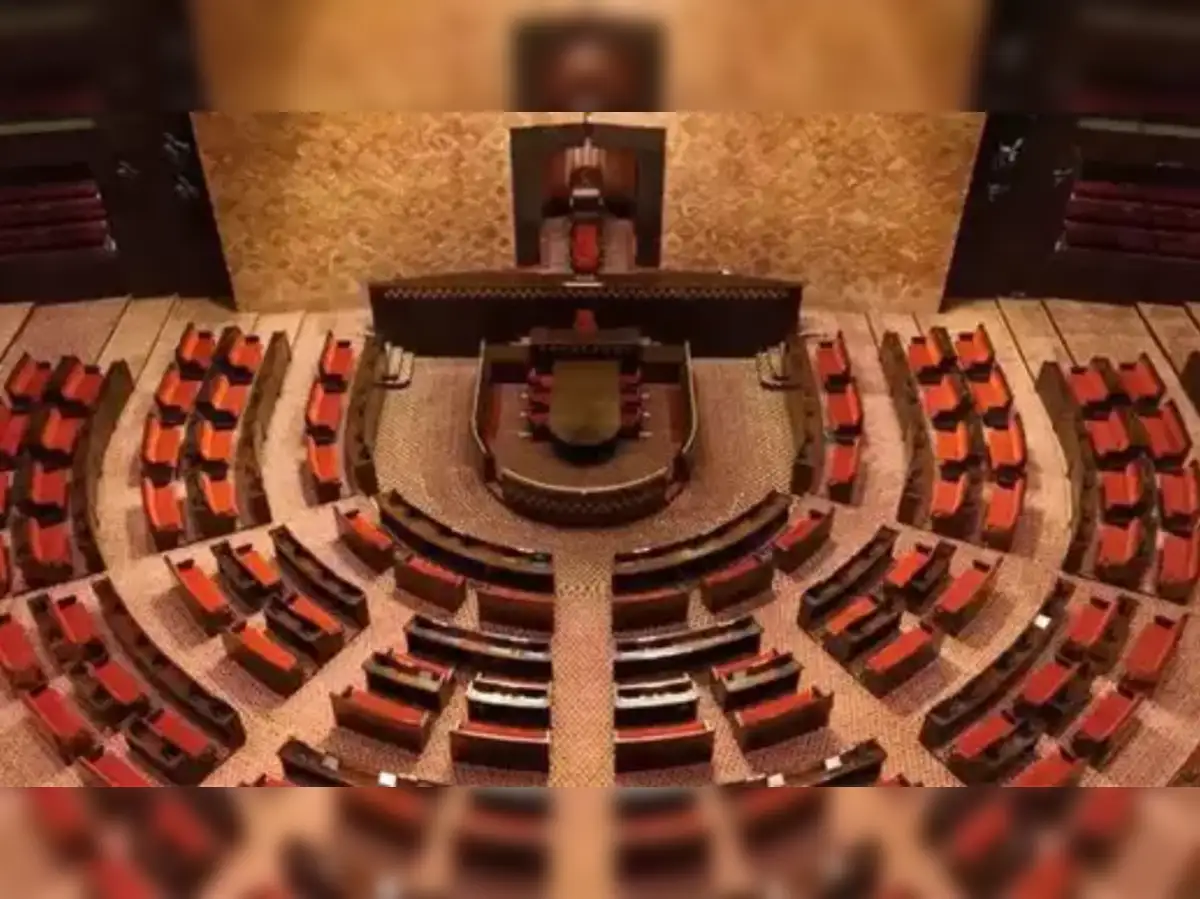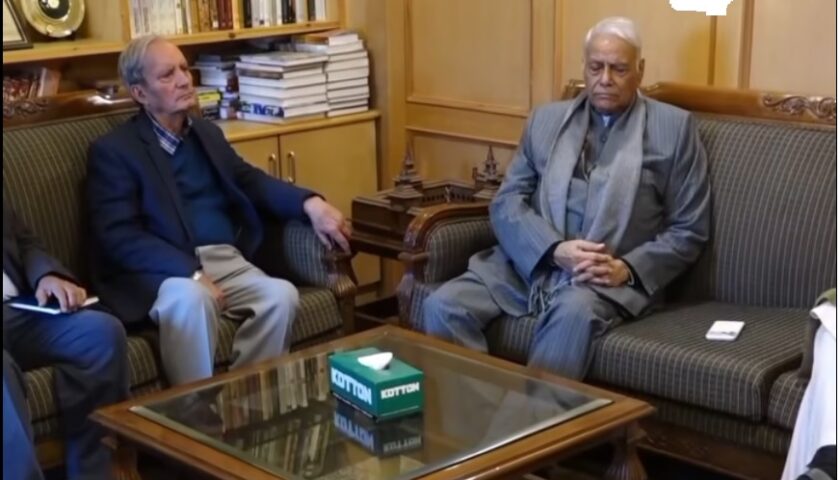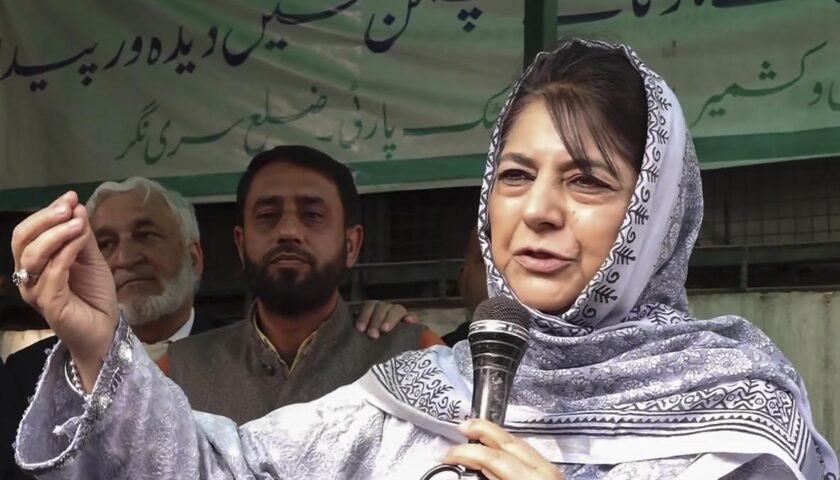As four Rajya Sabha seats and several Assembly by-polls approach, alliances are forming, ambitions sharpening—and voters watching closely.
By: Javid Amin | 08 October 2025
Jammu & Kashmir is simmering with political energy. With the Rajya Sabha biennial elections slated in late October/November 2025 and several Legislative Assembly by-polls on the horizon, every move by parties, every alliance, every aspirant matters. Behind closed doors, deals are being shaped; in towns and villages, hopeful candidates are quietly laying the groundwork. For many voters, this is less about big national narratives, and more about whether their voices are heard, their land is safe, their youth have opportunities, and whether “promises so far” translate into action.
In a region that has seen tectonic constitutional, administrative, and political shifts since 2019, the upcoming contests are as much about symbols as about seats. They’re about identity, power, legitimacy—and perhaps above all, about trust.
The Stakes: Rajya Sabha Biennial Elections
What Exactly Is at Issue
-
The Election Commission has announced that four Rajya Sabha seats from Jammu & Kashmir will be contested, with polling scheduled for October 24, 2025.
-
These seats have been vacant since 2021.
-
The outcome of these elections matters for two reasons:
-
Numerical power in the Upper House: more seats mean greater leverage for bills, policy debates, representation of J&K interests at national level.
-
Symbolic importance: who gets nominated, by whom, reflects how parties see their claim over identity, narrative, and how much control or patronage they can mobilize.
-
The Power Arithmetic
-
As per current composition in the Legislative Assembly, National Conference (NC), supported by Congress and smaller allies, is in a strong position to secure three of the four seats, leaving one likely for BJP.
-
The NC has signaled its intention to contest all four seats. Congress has claimed at least one seat, expecting coordination with NC.
-
BJP, though in opposition in the Assembly, has announced it will contest all four Rajya Sabha seats. But its realistic expectations are more modest: likely, it can aim to win just one, possibly through leveraging its own MLAs plus potential cross-voting, or support from independents.
Key Players & Tentative Names
-
BJP is being linked (in media speculation) to leaders such as Ravinder Raina and former deputy CM Nirmal Singh as frontrunners for Rajya Sabha candidacy.
-
NC-Congress alliance is expected to put forward their own picks. The names have not been officially confirmed openly, but NC is widely seen as having upper hand.
By-Polls in the Assembly: Testing Local Sentiments
Where & Why
-
At least seven Assembly constituencies are expected to go to by-polls, due to a combination of resignations, deaths, and disqualifications. Key constituencies under watch include areas in Kupwara, Rajouri, Anantnag, Jammu. (These are drawn from political reporting and monitoring of recent political shifts.)
-
These by-polls will serve as barometers of grassroots sentiment—how people feel about governance, promises made vs delivered, party presence, and whether newer players or independents are gaining traction.
What Political Parties Are Doing
-
NC and PDP are working to rebuild or reclaim lost ground, especially in constituencies where their support may have shrunk or been challenged.
-
BJP is focusing particularly on border constituencies and more urban or semi-urban seats in Jammu, where it tends to have stronger bases and infrastructural presence.
-
Congress, which is part of the NC-Congress alliance, is using by-polls to test its revival strategy—seeing whether it can rebuild relevance in areas it has lost.
-
Also, independents and civil society-backed candidates are entering the mix. There is visible discontent with “recycled” faces among local voters; among youth, women’s groups, and issue-based local grievances, the demand is for more responsive, accountable local representation.
Party Alignments, Negotiations & Possible Friction Points
Seat-Sharing & Alliance Tensions
-
The NC-Congress alliance (often referred to in media as part of the “INDIA bloc” or the broader opposition alignment) has in recent elections agreed to seat-sharing arrangements. For example, in the 2024 Assembly elections, NC contested 51 seats, Congress 32; there were allied seat allocations to smaller parties like CPI(M) and JKNPP.
-
However, friction exists: in the Rajya Sabha context, Congress is reportedly expecting one seat, but NC has expressed interest in contesting all four seats—potentially putting strain on existing alliance expectations.
-
Another vector of tension is with newer or smaller parties (e.g. Apni Party, DPAP) or defectors: they seek visibility and leverage in negotiations, particularly in by-polls where local clout can matter.
Defections, Realignments & Emerging Entrance
-
Since the abrogation of Article 370 and in the years after, there has been a noticeable number of political switching: leaders leaving PDP for Apni Party; people leaving DPAP back to Congress; defections or resignations from parties over candidate selection.
-
E.g. Choudhary Haroon Khatana (tribal leader from Kokernag) has resigned from DPAP and is expected to join PDP. Kokernag itself is a constituency now reserved for Scheduled Tribes, making the leadership’s local network important.
-
The emerging parties (DPAP, Apni Party) are pressing to avoid being sidelined; even where they lack strong electoral success lately, they may negotiate candidate slots or mutual non-contest understandings.
Possible Cross-Voting, Tactical Voting
-
Given multiparty alignments and some MLAs being independents or from smaller parties, cross-voting or tactical voting becomes a factor, especially for Rajya Sabha elections under the Single Transferable Vote (STV) system.
-
Also, it’s reported that some MLAs detained under certain orders (preventive detention etc.) may still have voting rights, which adds complexity.
Who Are the ‘Hopefuls’? The New Faces, Veterans, and Wildcards
Veterans & Established Leaders
-
Senior party figures from NC, Congress, BJP are expected to feature in Rajya Sabha and by-polls. Their names often surface in speculation before announcements.
-
For instance, NC has historically sought to leverage its senior leadership’s weight in nominations to Rajya Sabha and public perception. BJP too is expected to field recognized leaders rather than very new faces for upper house seats.
First-Timers, Local Strongholds
-
Many local leaders, former DDC members, or local councilors see by-polls as step ladders. Individuals who have strong ties in specific tribal belt or border constituencies, or who can mobilize local networks, are positioning themselves.
-
Social media is now a tool even in many remote constituencies: hopefuls are using video messages, local influencer endorsements to reach voters. Local grievances (road connectivity, health services, flood rehabilitation, school infrastructure) are central campaign themes.
Defectors & Political Switchers
-
Leaders who have switched parties, or are perceived as “looking for ticket”, are part of the hopefuls’ pool. Some are seeking refuge in parties with stronger winnability; others aim to leverage being outsiders to claim moral high ground (saying they were sidelined in prior structures).
-
But recent evidence suggests switching often comes with risks: many who switched have lost in recent Assembly elections. Looking at 2024, candidates who had frequently switched parties or lacked strong local base often failed.
Public Sentiment: Mood on the Ground
Expectations vs Disillusionment
-
Many voters express cautious curiosity: yes, they are paying attention, many are hopeful—but there is skepticism born of broken promises. Themes that keep recurring in local reporting:
-
Transparent candidate selection – people want leaders vetted, not selected purely by patronage or internal politics.
-
Issue-based campaigning, not just slogans. Infrastructure, local grievances, employment, services are what many care about.
-
Accountability – promises made during prior elections are often cited, not fulfilled or only partially fulfilled; people recall what was supposed to be done, and what still remains.
-
-
Youth, women’s groups, trade/unions in several constituencies are asking for more involvement—not just being spoken to, but included in planning, candidate choice, surveillance of promised works.
Learnt Lessons from 2024
-
The 2024 Assembly elections showed that new parties or those that try to ride protest narratives (e.g. ones formed post-2019) have largely struggled; established parties with strong ground organization (NC, BJP in respective regions, Congress to some extent) did better.
-
Independents had some success, but mostly in pockets where local identity, family/clan/ties, or specific grievances were powerful.
-
Defectors often failed unless they had strong personal brand in their constituencies. Switching parties may help with resources, but not always with trust among voters.
What Makes or Breaks Chances: Key Factors
From what is visible so far, several variables are likely to determine who wins what, and how strong the electoral outcomes will be.
| Factor | Why It Matters |
|---|---|
| Assembly arithmetic | Since Rajya Sabha seats are elected by MLAs, the composition of the J&K Assembly is everything. Coalition strength, independent MLAs, cross-benchers matter. |
| Seat-sharing clarity | Alliances that agree early, avoid overlapping claims, settle candidate lists early will have an advantage over those with internal friction. |
| Local visibility & ground work | Candidates who are known locally, are seen doing work (whether in the Assembly, local bodies, DDC etc.), have credibility tend to do better. |
| Party machinery & mobilization | NC, BJP have better party structures; emerging parties often lack same reach in more remote/troubled constituencies. |
| Voter turnout | Lower turnout in Jammu or in rugged border/troubled areas, or less interest in by-polls, may favour the party with better organizational ability and loyal vote banks. |
| Perceptions of identity & rights | In J&K, issues like land, demographic change, cultural preservation, special status, identity still matter as key motivators, especially in Kashmir Valley and among tribal/remote communities. |
| Campaign messaging vs delivery | Parties that can credibly show what they’ve done—even where limited—will have an edge over those with only promises. Past failure is a liability, but so is ignoring local grievances. |
Emerging Scenarios & Possible Outcomes
Given all the above, here are some of the plausible scenarios for how things might play out—both for Rajya Sabha seats and by-polls.
Rajya Sabha
-
Best Case for NC-Congress alliance: Wins three out of four seats. With disciplined vote transfers, minimal cross-voting, and leveraging MLAs (including independents aligned with them), the alliance could dominate. BJP may secure one seat, especially with strategic support.
-
Upset Potential: If cross-voting is significant, or if some MLAs defect or vote against their party whip, BJP might try to catch a second seat. Also, if smaller parties or independents extract deals (e.g. candidate swaps), outcomes could get interesting.
-
Alliance Strain: If Congress is denied what it considers its “fair share”, or if NC pushes alone in certain seats, friction could erode alliance goodwill, affecting longer-term cooperation.
Assembly By-Polls
-
Gains for NC in Kashmir Valley: NC likely to retain or win back some constituencies, especially where opposition is fragmented.
-
BJP might consolidate in Jammu: In border/urban/semi-urban Jammu, BJP stands a chance to hold or even expand seats, particularly where local governance issues (roads, employment, infrastructure) are salient.
-
Emerging parties / independents may upset status quo in smaller seats: Especially in tribal belt or constituencies where people feel neglected or under-represented. If a credible local leader runs (even as independent or from newer party), could pull off surprise.
-
Congress’s performance will be carefully watched: If Congress shows signs of revival (good candidate selection, clear messaging), it may regain confidence among voters in some seats, otherwise risk being seen as marginal again.
Challenges & Uncertainties
Legal, Regulatory & Administrative Hurdles
-
Rajya Sabha elections via STV can be opaque to voters; cross-voting or secret ballots make prediction harder, and allegations of horse-trading can arise.
-
Delimitation or reservation changes (for tribal seats, etc.) affect which seats are reserved, who can run—this reshapes who is eligible, which helps or hurts certain aspirants.
Security, Logistics & Voter Access
-
In J&K, especially more remote or sensitive border/troubled zones, turnout might be impacted by security conditions, weather, infrastructure.
-
ECI (Election Commission of India / local administration) performance and fairness in setting up booths, verifying voters, handling complaints will affect legitimacy and perception.
Public Fatigue & Disillusionment
-
Voters weary of promises unfulfilled may stay away or vote simply as protest.
-
Recycled candidates, nepotism, opaque selection can trigger backlash.
National Political Context
-
Actions, policies at the Centre also influence local mindset. Economic policies, central government approaches to J&K, funding packages, restoration of statehood or otherwise—all feed into local perceptions.
-
National alliances (e.g. INDIA bloc) will be judged not just locally but in terms of how cohesive and credible their promises are.
What Parties Must Do for Strong Performance
-
Early & Transparent Candidate Selection
Parties that announce candidates early, choose people with clean reputations and local acceptability, will inspire more confidence.
-
Messaging Rooted in Local Issues
Beyond general themes like identity or dignity, specifics: land rights, infrastructure deficits, school/health services, youth employment plans.
-
Grassroots Campaigns
Door-to-door, meetings with community/traditional elders, tribal leaders, youth groups, women’s collectives to understand grievances and build trust.
-
Alliance Management
Ensure allies or coalition partners feel respected: share seats, avoid public spats over nominations, handle internal dissent well.
-
Demonstrate Delivery
Even small visible projects completed, promises kept, grievances addressed can be powerful.
-
Attention to Voter Mobilization & Turnout
Especially in remote or challenging areas; ensuring polling booths are accessible; voters are aware; transport is possible; security is assured.
Bottom-Line: A Critical Moment for Democratic Credibility
The upcoming Rajya Sabha elections and by-polls in Jammu & Kashmir are much more than periodic contests. They are a test: of alliances forged since 2019, of parties’ ability to deliver, of whether new voices will matter, and whether people can trust political promises again.
For political parties, there is a narrow window to act: to pick credible candidates, to address real grievances, to demonstrate capacity and integrity. For voters, there is an opportunity: to demand accountability, to insist on issue-centred representation, to reject hollow sloganeering.
In Jammu & Kashmir’s democracy—and in the contest for trust, land, identity, and dignity—the hopefuls must offer more than hope.




